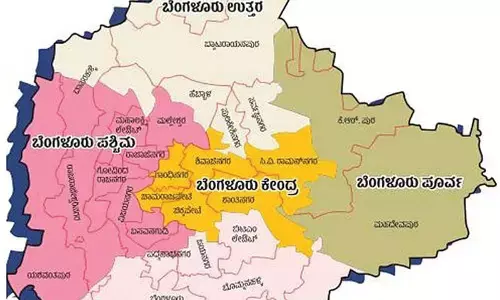Uncleaned water tanks cause waterborne diseases: DPO

A water tank in a village in Anantapur used by people.
While the rulers should apply their mind on protected drinking water, sanitation and good roads in every village, provision of protected drinking water including maintenance of water infrastructure must top the priority list of government.
Anantapur: While the rulers should apply their mind on protected drinking water, sanitation and good roads in every village, provision of protected drinking water including maintenance of water infrastructure must top the priority list of government. The most neglected job is the maintenance of drinking water infrastructure including mini-reservoirs, overhead tanks and leaking pipelines. People's health is taken for granted. Negligence and poor or no allocation of funds for cleaning overhead tanks is the cause for waterborne diseases which also take a toll of people's life and health. Waterborne illness is caused by recreational or drinking water contaminated by disease-causing microbes or pathogens.
Of note, many waterborne pathogens can also be acquired by consuming contaminated food or beverages, from contact with animals or their environment, or through person-to-person spread. Waterborne illnesses can cause a variety of symptoms. While diarrhea and vomiting are common reported symptoms of waterborne illness, other symptoms can include skin, ear, respiratory, or eye problems. Hundreds of overhead tanks in rural areas remain uncleaned for months and in some cases for years.
It is a common knowledge that those living in slums and in sub-human unhygienic conditions have higher immunity levels than those living in clean surroundings and protected environment in metro cities and urban areas. So, when governments fail on the hygienic front, the higher immunity levels enjoyed by people sometimes saves the day for either state or local governments.
Barring a few, majority of overhead tanks are not cleaned while maintenance protocols in panchayats suggest cleaning tanks once in every fortnight. Some panchayat staff say that they do not have funds for maintenance. According to sources in municipal regional directorate, except for Anantapur city, all other municipalities are operating through the ageold water supply pipelines which have multiple leakages.
The leakage points are the locations where drainwater mixes with good water and becomes the breeding centres of mosquitoes which in turn spread diseases like malaria, filaria, chikungunya etc. The rusted pipelines become the cause of waterborne diseases including cancer.
District Panchayath Officer Prabhakara Rao told The Hans India that it is mandatory for staff to clean water tanks every 15 days and chlorinate the water every day in the panchayat villages. He assured that he would undertake a cleaning drive and find out violations if any in this regard. Strict instructions will be given for the maintenance of water infrastructure in the district.
In Tadipatri, where there are multiple industries and even granite processing units, people complain that the granite waste is released into the water sources and water gets polluted. There is also widespread criticism on the private water plants' operators, who also does not follow hygiene protocols and there is none to inspect these plants. The private operators are allegedly supplying polluted water to consumers, who are taken for a ride. Rural Water Supply officials were unavailable for comment on the poor maintenance of water supply infrastructure.















